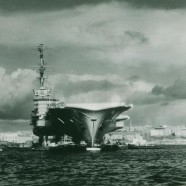(Français) La collecte sélective des déchets électriques et électroniques est une mesure de salubrité publique
Tomorrow, the United States launches a Submarine Aircraft Carrier
The sea is in its garbage finery once more. Tomorrow, when the Clemenceau is scheduled to arrive in Brest, the Oriskany, a former American aircraft carrier, will be deliberately sunk. This is to the satisfaction of leisure business, tourists and scuba diving enthusiasts who see in this programmed sinking a new pole of attraction, curiosity and revenue. Diving clubs have already started taking bookings: 145 USD for two, payable in advance.
In Canada and the United States, a lot of mega-bulky waste that no one knows what to do with at the end of their life is thrown into the sea as part of artificial reef programs. Everything goes: Boeings, subway trains, and old cars.
Shipwreck of an aircraft carrier in the United States
The 17th of May 2006, the US Navy will sink 27,000 tons of metal valued at 9.7 million US dollars* with the force of 24 charges of explosives. The Oriskany’s immersion constitutes the first stage of a program, created by the American administration in 2004, specifically designed for the underwater re-usage of surface ships as artificial reefs. This initial venture will take place in the Gulf of Mexico whose waters have been historically contaminated by hydrocarbons, heavy metals, and PCBs and more recently plagued by the effluents of Hurricane Katrina’s natural and industrial disaster in 2005. The hull of the ex-Oriskany contains more than 350 kg of residual PCBs as well as asbestos and toxic paint. Regional dive clubs welcome this ecological disaster. In the long run, the fish attracted by this new trash heap will be subjected to a toxicological follow-up determining whether or not they are harmless in the event of consumption by divers.
“The Love Boat”
According to the latest press news, the Norway (ex-France) Ocean liner will be sent to the ship breakers; instead of Bangladesh it could be sent to Alang beach in India. Before being towed to Port Kedang in Malaysia the 23rd of May 2005 where she is waiting for the final decision from the owner, Genting Corporation (which is the largest financial group of Malaysia), the Norway was docked for 18 months at Bremerhaven in Germany (1). Public opinion, the Green Party, ecologist movements and the German Authorities were not interested in her fate. This endangered masterpiece was guarded in Germany by a Nepalese crew of 45. The Norway is a masterpiece in danger but also a health, a medical and an environmental hazard: one of the engine rooms of the Norway blew up causing a deadly explosion which happened in May 2003, spreading the asbestos from the insulation at least to the third bridge of the ship. The Norway is a double victim of the asbestos pollution : she suffered the “passive” pollution from the fire protection, and heat insulations, but also from an “active” pollution due to the explosion. Despite the foggy image left hanging in illusion by her owner in the direction of a re-conversion, nobody ever really believed in any other destination for the Norway except the ship breakers’; for this temple of asbestos, the Basel Convention, the pre-treatment and the extraction of the other hazardous substances and pollutants such as the PCB’s (Polychlorinated biphenyls) were never addressed.
In the port of Amsterdam
The European Union has entered naval shipbreaking business. The discarded ships will begin to be dismantled and supply the steel industry with millions of tons of recyclable scrap metal. Today, France remains removed from this development, and it is the Netherlands that leads the way.
The Sandrien, a vessel of Bolivian origin, is being dismantled in the naval repair yard in Amsterdam; following the Sandrien’s deconstruction, the same yard will also scrap the Otapan (167 m long). Seized by the Minister of the Environment, the Dutch Tribunal considers a vessel destined for scrapping as waste. Consequently, the Sandrien could not rejoin Asian yards. If it wishes, the German government could do the same with the ex-France liner.











